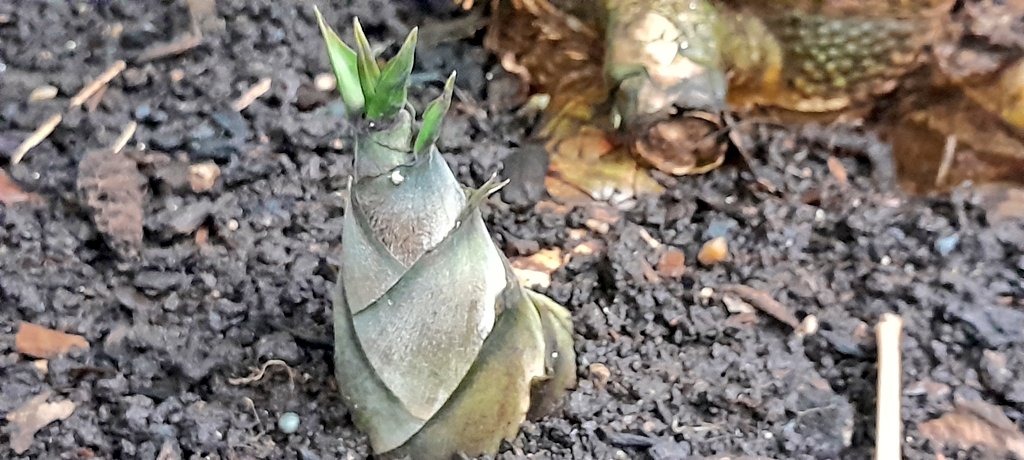The colours of the bamboo leaves are a good indicator of the plant’s general health. Like other perennials, the natural colours of the foliage shows that plant is thriving.
When bamboo leaves turn yellow or curl - or the stems turn brown - it may mean that it needs immediate attention. The yellowing of the leaves is called Chlorosis.
This article suggests how to revive bamboo leaves turning yellow by applying bamboo-saving interventions.
Temperature changes cause yellowing/curling of leaves
Outdoor temperature (Frost):
Bamboos can withstand temperatures below 0 degrees, they are winterhardy. But extreme cold and frost in Winter can kill the new plants.
There is little you can do to avoid the weather, however, adding mulch (preferably grass cuttings) to create a humus reach base around your bamboo will protect the plants from the Winter’s cold.
Indoor temperature (Heat):
Bamboos in containers can succumb to indoor heat and temperature fluctuation.
If the heat is too high or the surrounding heat change abruptly, the leaves of the bamboo plant will roll into a curl to protect themselves from water loss.
Heat also can cause brownness around the culms (stems). So, keep them in check so that they do not succumb to indoor heat.
Fertilisers with an equal proportion of Nitrogen to Phosphorus to Potassium are ideal for bamboo plants. The Universal Granules (Slow-release) Fertilisers are ideal for bamboo plants,
Buy Slow-release Fertilisers from top UK suppliers here.
Why Do Bamboo Leaves Turn Yellow?
The bamboo leaves turn yellow due to a number of reasons. The common causes of yellowing leaves and curling leaves are stated above.
In addition, the main causes of distress in bamboo plants are nutrient deficiency, bug infestation, and availability of water.
Here are ways to address the distress in your bamboo plants.

Bug infestation:
It's rare in the UK to see bamboos infected with bugs. But, it is common in tropical areas where bamboo is a native plant.
Perhaps, it is important to check for spider webs and wasp nests in the leaves.
For indoor plants, make sure the leaves are dust-free.
What gathers on the leaves disturbs them from getting enough sunlight and eventually slows the rate of photosynthesis which can lead to an unhealthy plant.
Moisture stress:
Lots of water or no water in the soil is another common cause of yellowing bamboo leaves.
Check the top layer of the soil to a depth of 5 cm - 10 cm.
Dig or dip a bamboo stick into the soil and check the moisture present in the soil. Water the plants generously, even in Winter.
Check out this article on How to Revive Lucky Bamboo Plants.
Chlorosis of bamboo leaves
Chlorosis is the yellowing of leaves in plants due to a number of reasons such as temperature variations, bug infestations and moisture stress.
Other factors that are likely to cause chlorosis of bamboo plants include:
- poor drainage,
- damaged roots,
- compacted roots,
- high alkalinity, and
- nutrient deficiencies.
How to improve soil nutrient content (Bamboo-saving interventions)
If you realise that bamboo leaves turn from green to pale yellow, it indicates that they are low on nitrogen, phosphorus and potassium.
Do not remove the yellow leaves or cut the plant.
Apply fertilisers or a recommended plant feed high on N, P and K once or twice a year, ideally in early Spring.
In fact, adding NPK fertilisers will improve the growth of new shoots and leaves in the next growth year. Your bamboo will, once again, produce healthy rhizomes, shoots and leaves.
Check out the list of top UK Home & Garden suppliers for all you gardening needs.
Revive bamboo leaves curling
Bamboo leaves curling inwards happens as a result of two things: either there are bugs camping in the leaves or it’s too hot for the plants.
Some spiders and wasps build webs and nests using the leaves as cocoons. Usually, insects will use a few leaves, even one, to nest and cause no harm to the leaves.
The main cause of curling leave is heat.
Bamboo leaves are thin and elongated, they lose a lot of water through transpiration. If it is too hot, the leaves curl inwards to protect themselves from high water loss.
To revive the curling bamboo leaves, give them enough water. Move the potted plants to windowsill or outdoors for the leaves to unfurl.
Yellow leaves on bamboo fall off
Bamboos are a tough group of plants, their leaves are quite tough the plants.
The leaves grow to full length and strength at about the same time as the main bamboo and live as long as the bamboo is standing.
When the leaves fall off, it could mean the bamboo is old. Cut the culms so that new shoots will grow.
However, you should be concerned if the leaves start to fall off a plant that is 5 years old or younger. It means the soil is lacking nutrients.
Check the soil and condition of the plants. Applying one of the methods discussed above to revive them.
Check the link, for more info about bamboo care and maintenance.





